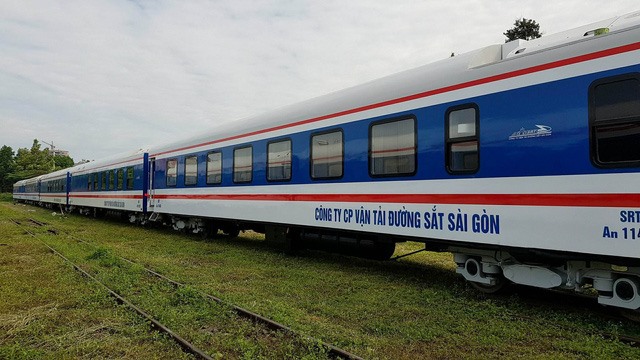VNR to offer new conveniences in 2018
 |
| Vietnam Railways (VNR) will institute improvements in service quality and infrastructure to compete with the civil aviation and road transport sectors in 2018.– Photo tuoitre.vn |
Data by VNR shows that, up until July, 2016, the company stopped a precipitous fall in profit and passenger numbers. However, its financial results for 2017 were negatively affected by severe natural disasters.
Vũ Anh Minh, head of VNR’s member council, told Vietnam News Agency that the country rail infrastructure had to be upgraded and provide better services to attract passengers.
Focusing on creating genuine experiences, Minh stressed upon the significance of passenger-oriented strategies, starting from innovating train carriages.
In 2018, the company plans to build six to ten new trains, upgrade existing ones and import locomotives, aiming to comprehensively improve its service quality by 2020.
According to Minh, a domestic-built carriage costs about US$500,000 (VNĐ11 billion) each while the price of a Spanish-made carriage, for example, is up to €1.5 million (VNĐ30 billion). On the other hand, a foreign carriage’s design is not suitable for Việt Nam’s terrain and less developed infrastructure.
Therefore, VNR asked Việt Nam Development Bank (VDB) to provide a loan of VNĐ3,200 billion ($140 million) to invest in innovation projects.
On January 10, VNR will officially launch six five-star trains on the Reunification (Hà Nội – HCM City) route. Other improvements in food, ticket booking and other services will also be introduced. Meals produced by Southern Airports Services Joint Stock Company (SASCO) will be piloted on VNR’s trains from the same day.
“A meal costs from VNĐ25,000 to 30,000 ($1.1 – 1.3) included in a ticket price, meanwhile, the ticket’s price is unchanged. This is our tactic to lure passengers’ interest in railway transport,” Minh said.
Additionally, VNR will distribute tickets for holidays six months early and offer promotional fares as the number of trains will be increased. “The six five-star trains launched on January 10 will show whether improvements satisfy passengers’ demands,” Minh said.
He also expected that the experiences created by VNR’s five-star trains would awaken passengers’ interests and switch the way they travel.
“People turned their backs on railway because of its poor quality, not high price. Therefore, we try to present better services while tightening cost management to increase the number of passengers, raise revenue and gain profit,” Minh explained VNR’s plan.
About the further development, Minh emphasised on capacity enhancement to gain a higher market share.
“When the Nội Bài – Lào Cai Expressway was opened, a lot of passenger chose to travel by road. Since then, we have carefully learnt our strengths to improve services and compete with other means of transportation. Moreover, we believe our efforts will encourage other service providers to improve and offer better experiences for passengers,” he added.
After a fortnight of use, automatic ticket gates at main stations have shown an inability to detect inaccurate information of passengers.
When a valid train ticket issued by VNR and with the correct departure time is scanned, a gate will automatically open for passengers to board the train. However, according to Sài Gòn Railways, one ticket can be used several times. Moreover, automatic ticket gates cannot tell if holders have the same information as indicated on tickets or not.
Despite automatic ticket gates, railway officers have to recheck information.
Therefore, Sài Gòn Railways asked VNR to tighten ticket management and add functions to respond to passengers’ demands.
From December 15, 2017, automatic tickets gates scanning QR codes on boarding passes were installed in Hà Nội and Sài Gòn Railways Stations.
What the stars mean:
★ Poor ★ ★ Promising ★★★ Good ★★★★ Very good ★★★★★ Exceptional
Related Contents
Latest News
More News
- Protect what’s next: towards a future free from meningococcal group B disease (December 05, 2025 | 18:00)
- New ILO report offers policy recommendations for disability inclusion (December 04, 2025 | 15:18)
- Maternal job loss may affect children’s mental health, research shows (December 03, 2025 | 19:11)
- Women lead Vietnam’s shift to climate-resilient agriculture (December 03, 2025 | 19:10)
- Experts highlight unpaid care work as key barrier to gender equality (December 03, 2025 | 15:15)
- Opportunities and inequalities for women workers in Vietnam's garment industry (December 03, 2025 | 09:00)
- Vietjet flights carry love to devastated central region (November 28, 2025 | 11:35)
- New initiative to boost the fight against domestic violence (November 26, 2025 | 10:00)
- South Korea funds IOM relief for Vietnam’s typhoon-affected communities (November 24, 2025 | 15:33)
- AI and human-centred values set to shape the future of HR in Vietnam (November 21, 2025 | 18:04)

 Tag:
Tag:





















 Mobile Version
Mobile Version